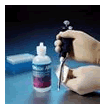PIPETTE CLEANING
Pipette cleaning is an important part pipette maintenance and repair. A pipette is subjected all manner of materials in a laboratory environment, from chemical dust to biological materials.

These contaminants may be both on the outside of the pipettes or be found within the internal components. The effect of this is two-fold:
1. Biological materials may be harmful to a user or may contaminate work in progress and affect results. PCR work and contamination with RNA/DNA is a good example.
2. The performance of the pipette may be affected.
Basic Cleaning
This can be undertaken quite simply by following the manufacturers instructions for disassembly of the pipette and cleaning the various components with a suitable cleaning fluid, such as diluted ethanol and a soft cloth. Inspection of the components should also be undertaken at this time for damage and wear and tear. On other occasions specialist fluids may be required for example to remove nuclease and DNA contamination.
Pipette Decontamination needs addressing where pipettes
are used with dangerous, corrosive or biological materials.
The photo below shows two pistons from a Gilson Pipetman
which are both corroded and have blood contamination.
This cannot be seen when a pipette is being used and
care must therefore be taken in these procedures. In
this case blood has been aspirated up the tip cone
and therefore this will also be contaminated. The corrosion
is due to use of an acid that produced a corrosive
vapour. These pipetting situations would benefit from use of
tip cone filters.

 In
these situations follow the manufacturers advice,
but most will recommend that for biological material
the mechanical parts are at least subjected to
full immersion in a non-corrosive disinfectant. How long depends on
the "load" of contamination, some which may need removing manually using
gloves and suitable cleaning agents and tools prior to further decontamination.
Autoclaving may well be necessary prior to any
action if the contaminants are transferable or
potentially dangerous. Service and repair companies
will invariably ask for pipettes to be decontaminated
prior to being serviced or calibrated as part if
their Health & Safety protocols.
In
these situations follow the manufacturers advice,
but most will recommend that for biological material
the mechanical parts are at least subjected to
full immersion in a non-corrosive disinfectant. How long depends on
the "load" of contamination, some which may need removing manually using
gloves and suitable cleaning agents and tools prior to further decontamination.
Autoclaving may well be necessary prior to any
action if the contaminants are transferable or
potentially dangerous. Service and repair companies
will invariably ask for pipettes to be decontaminated
prior to being serviced or calibrated as part if
their Health & Safety protocols.
Autoclaving of a pipette should be done under guidelines laid down by the manufacturer. Some pipettes are fully autoclavable (the Biohit mLINE for example) whereas others (e.g. Gilson Pipetman) may only have the tip cone assembly (piston etc) autoclaved. On most pipettes, recalibrating is recommended after a number of autoclaving's. As autoclaving involves increased temperatures, humidity and pressures the mechanical components can become affected and their relative tolerances changed. This may result in incorrect calibration and therefore needs checking.
Most good pipette calibration and service companies will provide
advice and a decontamination form to be completed. We would always
recommend good laboratory practice be folowed and use of protective
glasses and laboratory nitrile
gloves when cleaning
pipettes.
![]()
See more about autoclaving
